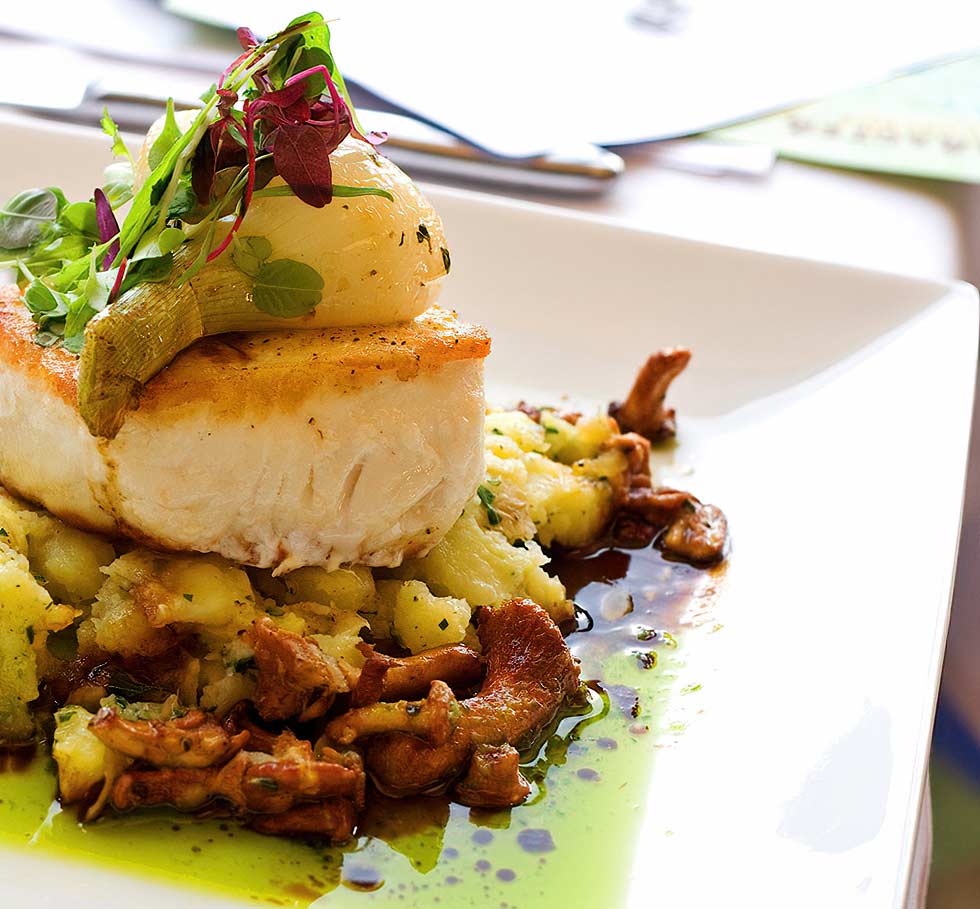Looking for a delicious, easy-to-prepare dish that combines the delicate flavor of halibut with the heartiness of sautéed potatoes and mushrooms? This baked halibut recipe is an excellent choice for a family dinner or a special occasion. Combining crispy sautéed potatoes, earthy mushrooms, and tender baked halibut will leave your taste buds wanting more. Not to mention, it’s a healthy and flavorful meal that’s perfect for seafood lovers!
Preparation Time
Prep Time: 15 minutes
Cook Time: 35 minutes
Total Time: 50 minutes
Ingredients (Serves four people)
- 4 halibut fillets (about 115 grams each / 4 oz)
- 4 medium potatoes, peeled and chopped
- 1 cup shiitake or chanterelle mushrooms, sliced
- 4 whole green onions, cleaned and trimmed
- 3 tablespoons olive oil (plus more for drizzling)
- 2 cloves garlic, minced
- Salt and pepper, to taste
- Fresh herbs (like parsley or microgreens) for garnish
- 1 lemon, cut into wedges (optional)
1 tablespoon is circa 15 ml, and a teaspoon is circa 5 ml.
Preparation Method
Step 1: Preheat the Oven
Preheat your oven to 190°C (375°F). While the oven is heating, prepare the ingredients for the dish.
Step 2: Sauté the Potatoes
Heat 2 tablespoons of olive oil in a large skillet over medium heat. Add the chopped potatoes and cook for 8-10 minutes until they soften and turn golden brown. Once they are cooked, remove them from the skillet and set them aside to rest.
Step 3: Sauté the Mushrooms
In the same skillet, add another tablespoon of olive oil if necessary. Add the sliced mushrooms and garlic, cooking for about 5 minutes until the mushrooms are tender. Season with salt and pepper, and remove from heat.
Step 4: Prepare the Halibut
Drizzle the halibut fillets with olive oil and season them with salt and pepper. Place the halibut fillets on a baking sheet lined with parchment paper.
Step 5: Bake the Halibut
Place the baking sheet in the oven and bake the halibut fillets for about 15 minutes, or until the fish is opaque and flakes easily with a fork. While the fish is baking, prepare the green onions.
Step 6: Roast the Whole Green Onions
In the last 5 minutes of baking the halibut, add the whole green onions to the oven on a separate baking tray. Lightly drizzle them with olive oil and roast until tender and slightly caramelized.
Step 7: Assemble the Dish
Once the halibut is fully cooked and the onions are roasted, it’s time to plate the dish. Begin by placing a layer of the sautéed potatoes on each plate, followed by the mushrooms. Then, carefully place a halibut fillet on top. Garnish with roasted green onions and fresh herbs.
Step 8: Add a Final Touch
For an extra burst of flavor, drizzle a bit more olive oil over the top of the dish and serve with lemon wedges on the side.

Tips and Tricks
- Alternative Mushrooms: If you don’t have shiitake, try using button, cremini, or chanterelle mushrooms.
- Crispier Potatoes: Parboil for 5 minutes before sautéing them to achieve extra crispiness.
- Herb Variations: Fresh thyme or rosemary can add incredible flavor to the dish.
- Chef’s Recommendation: Adding a small sprinkle of flaky sea salt just before serving enhances the flavors of halibut and the vegetables.
Serving Suggestions
This dish pairs beautifully with a simple green salad or roasted vegetables like asparagus. A slice of crusty bread can be a great addition to soak up the flavorful juices from the halibut and potatoes.
Wine Pairing
This dish pairs wonderfully with a white wine that complements the light, delicate flavors of the halibut and the richness of the sautéed potatoes and mushrooms. A Bulgarian Chardonnay or Misket would be ideal, as these wines have crisp acidity and subtle fruity notes that enhance the fish’s natural flavors while balancing the dish’s richness.
Nutritional Information (per serving)
- Calories: 400 kcal
- Protein: 35g
- Fat: 18g
- Carbohydrates: 25g
- Fiber: 4g
Dietary Modifications
- Gluten-Free: Naturally gluten-free, this recipe is suitable for those avoiding gluten.
- Dairy-Free: To keep it dairy-free, stick to olive oil and avoid using butter.
Storage Suggestions
- Refrigeration: Store any leftovers in an airtight container in the refrigerator for up to 2 days. Reheat gently in the oven or stovetop to avoid overcooking the fish.
- Freezing: It’s best to consume this dish fresh. However, if you need to freeze it, wrap the halibut fillets tightly in plastic wrap and store them in the freezer for up to 1 month. Reheat after thawing overnight in the fridge.
About the Halibut (Камбала)
Halibut, known as Камбала in Bulgarian, is a firm, white-fleshed fish that is low in fat but high in protein, making it a nutritious option for those looking to maintain a balanced diet. Native to both the Atlantic and Pacific Oceans, halibut is one of the largest species of flatfish, with some reaching sizes over 400 kilograms. This mild-flavored fish is perfect for baking, grilling, or pan-searing, and it pairs beautifully with various sides and sauces.
Incorporating halibut into your diet supports heart health and provides a great source of omega-3 fatty acids, which promote brain function and reduce inflammation. Whether cooking it for a weeknight meal or a special occasion, halibut is a versatile and delicious seafood option that never disappoints.
Cultural Context
In Bulgaria, fish like halibut have historically been part of coastal communities’ diets, reflecting the Mediterranean influence on Bulgarian cuisine. Although not as commonly served as river fish, halibut has found its place in modern Bulgarian kitchens. It offers a high-quality source of lean protein and subtle, refined flavors that pair well with local wines and fresh produce.


